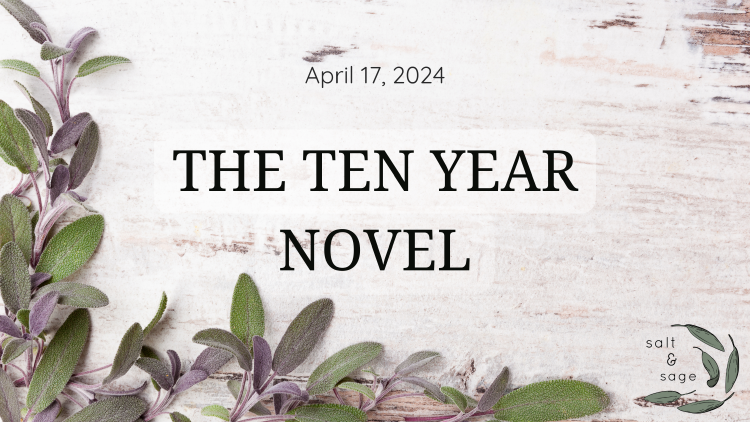This blog post accompanies our podcast episode, The Ten Year Novel.
The ten year novel. That book that you can’t finish; the one that’s haunted you for years and years. It might be your first, it might be your fifteenth, but we’ve all experienced the pull of a story we can’t quite finish.
As it sits, it becomes something different. That denizen of the bottom desk drawer. Our repeated literary necromance. Our own personal scripture, a treasure chest we fill with idea nuggets and scraps.
We see the ten year novel pop up a lot in our work supporting writers taking their work to the next level. Let’s talk about this and some approaches some people take towards the care and feeding of their own preciouses.
First: is the 10 year novel a problem?
A lot of approaches to the 10 year novel seem to assume it’s a problem. That’s not always true. Some ideas simply take time to gestate. It’s your process and your work–you don’t have to adhere to someone else’s idea of success or production schedule. Sometimes the approach to writing as product manufacture isn’t right for all projects or all people.
Some creative tasks emphasis process. Quilting, for example, focuses a lot on how things are done. Writing often defaults to how many things can be done, and how quickly–but it’s also totally fine to approach quilting as a product-driven race and approach writing as something we do slowly for our own enjoyment.
When is the 10 year novel a problem?
If you’ve been trying to finish your heart’s book and move on, the ten year book can keep you stuck in a toxic relationship that isn’t progressing but that you also can’t quit.
If that’s your wrestle, then there are a few approaches you could try to get unstuck.
Writer’s Block & Theme
If you can’t finish the story, look at the plot. Plenty of us get stuck there–we’re not sure what happens next, so nothing happens next. Theme is a great place to get those ideas sorted out, because everything in your plot should serve as a connection to that core theme.
If you’ve never thought about your theme before, don’t worry. Think about all the stories you’ve written, or even the plots and subplots that you read. Nearly all of us have a theme we’re writing about, and it shows up in our work and our leisure reading. Most of us dance around a few wounds in our work.
If you’re still stuck on what your theme is, and therefore which way your plot should go, try Gary Truby’s method. He says that story is ultimately our answer to the question, “What is the good life?” How would your characters answer that question?
Outside Help
Sometimes, we’re just too close to the project. Our ten-year novels have often spent more than ten years on our minds, and we’re deeply invested in them. We know backstories of even the most inconsequential character! That amount of knowledge can make it difficult to narrow down what you include on the page.
If you’re too close to your piece, it’s time to call in reinforcements.
Having a fresh perspective from a critique partner, beta reader, or developmental editor can be a lifeline. Not only can they see your project with fresh eyes, they can also help you figure out what should happen next. They might even have some insight into your theme.
It’s not easy to let someone else look at your project, but remember that it’s also not easy to have that ten year novel waiting in your computer.
Emotional Reasons
Of course, your problem might not be any of the above. You might know exactly how the story is meant to end, but just still can’t quite get there.
There’s a lot of stigma around having that unfinished novel. It’s okay if you need to wrestle with that first. You might feel ashamed that the novel isn’t done… and our advice is actually to put it on pause and try writing something different.
You might try writing something in a different genre–maybe something you’ve enjoyed in the past, but which has less weight of expectations for you. Your ten-year novel is obviously important to you, or you wouldn’t have held on to it this long. Shifting genres can give you a fresh start, something that has no ties to the big project you’re working on.
You might also like to try different lengths. Shorter pieces, like a novella, short stories, or poetry, might help you focus more on story elements and less on length. Plus, it’ll let you practice finishing stories.
You can also work on more specific, structured writing tasks like blurbs, queries, and elevator pitches. These are like little story snow globes–small, adorable, perfectly self-contained. All those tasks require all the main parts of a story be present, but are small and short enough that they’re less intimidating. Plus, the time investment is shorter–you can create 10 varions on one blurb, or 30 different blurbs from mediocre to brilliant. If you want to write blurbs for your big novel, do it! But if you don’t want to, no sweat. The point is to practice seeing what’s working and what isn’t.
Be Kind To Yourself
Above all, keep your inner goblin happy. Ten year novels aren’t a waste. They’re a treasure, and they’re all yours. If they’re not ready to move on to the next level, that’s okay. They can be your personal treasure hoard. You can draw from them to create other works that also contain darlings you love. Who knows? Maybe your other works will help you understand whatever it is you need to know in order to finish your ten-year novel. And if not, then at least you got the chance to play stories with your long-term invisible friend.
Join the conversation over on our youtube channel or on your favorite podcast platform.
















